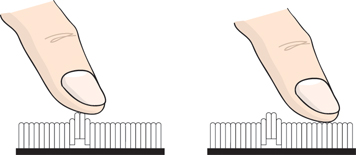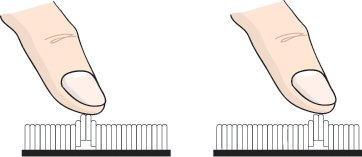A fresh look at the old analogy of an office desk informed the interface.
It was decided that the interface mimick elements in reality so as to be more intuitive to the user.
The command differentiation for reading is incumbent on the user applying less than median force to the surface. If this force tolerance is exceeded, the system will interpret the action as a "click"
During a drag, since the resolution is better than 1/4 a Braille cell, every cell may be rendered faithfully through the drag. With resolutions approaching 1:1 proportions of pixel to Braille cell, the intermediate spaces become limited in their ability to render a cell with fidelity.
The keyboard pads output to a specific distance in relation to the pads. This mimicks physical Braille type writers and allows the user to place their edit points in a manner they are familiar with.
Once the application has been dragged onto the desktop, it is removed from the drawer.
The limitations of the pin surface necessitated the creation of a system to "bring a page to the front". In traditional GUI terms, this was a question of assigning "focus" and "blur". This was overcome by using three fingers of each hand and dragging to bring a page to the front. Conversely, this method works well for bringing pages to the rear.
This mechanism is tenuous as it is a sighted convention. Kennedy's experiments with the blind discovered an unfamiliarity with the concept of overlap.
It was decided that the interface mimick elements in reality so as to be more intuitive to the user.
Reading
Standard Braille is the primary language the system is designed for. However, in this prototype, since each "pin pixel" has a resolution of roughly 1/4 a Braille cell, graphics, as well as traditional text, may be displayed.The command differentiation for reading is incumbent on the user applying less than median force to the surface. If this force tolerance is exceeded, the system will interpret the action as a "click"

Dragging
In comparison to reading, the dragging operation requires a threshold of force to be exceeded to initiate the action.During a drag, since the resolution is better than 1/4 a Braille cell, every cell may be rendered faithfully through the drag. With resolutions approaching 1:1 proportions of pixel to Braille cell, the intermediate spaces become limited in their ability to render a cell with fidelity.

Input
Input follows the standard six-key Braille input system where each key is linked to a corresponding dot in the 2x3 Braille array.The keyboard pads output to a specific distance in relation to the pads. This mimicks physical Braille type writers and allows the user to place their edit points in a manner they are familiar with.
Application Launching
The metaphor for application launching is that of opening a drawer.Once the application has been dragged onto the desktop, it is removed from the drawer.
Application Handling
Applications are treated as sheets of paper on a desk.The limitations of the pin surface necessitated the creation of a system to "bring a page to the front". In traditional GUI terms, this was a question of assigning "focus" and "blur". This was overcome by using three fingers of each hand and dragging to bring a page to the front. Conversely, this method works well for bringing pages to the rear.
This mechanism is tenuous as it is a sighted convention. Kennedy's experiments with the blind discovered an unfamiliarity with the concept of overlap.